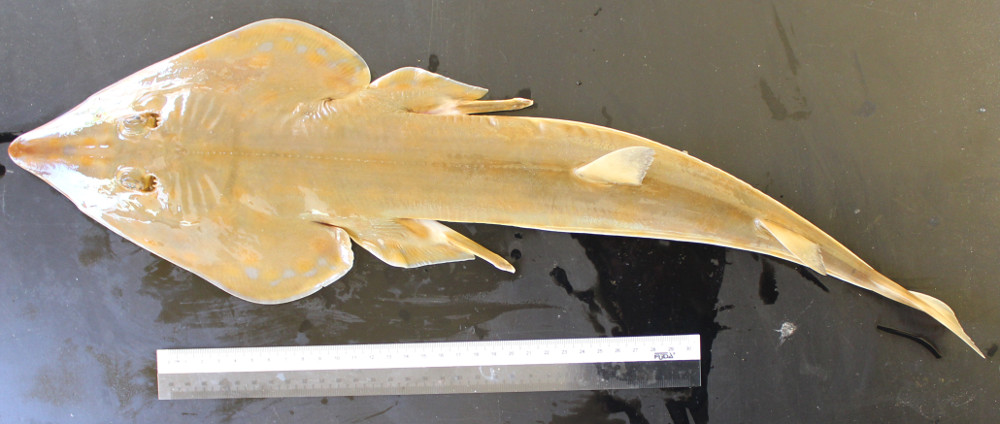Acroteriobatus variegatus
(Nair & Lal Mohan, 1973)
Stripenose guitarfish
Classification: Elasmobranchii Rhinopristiformes Rhinobatidae
Reference of the original description
On a new deep sea skate, Rhinobatos variegatus, with notes on the deep sea sharks Halaelurus bispidus, Eridacnis radcliffei and Eugaleus omanensis from the Gulf of Mannar. Senckenbergiana Biologica, 54(1/3), 71–80
On a new deep sea skate, Rhinobatos variegatus, with notes on the deep sea sharks Halaelurus bispidus, Eridacnis radcliffei and Eugaleus omanensis from the Gulf of Mannar. Senckenbergiana Biologica, 54(1/3), 71–80
Image of the original description
Image in copyright.
Image in copyright.
Synonyms / new combinations and misspellings
Glaucostegus variegatus, Rhinobatos variegatus, Rhinobatos (Acroteriobatus) variegatus
Glaucostegus variegatus, Rhinobatos variegatus, Rhinobatos (Acroteriobatus) variegatus
Description :
Citation: Acroteriobatus variegatus (Nair & Lal Mohan, 1973): In: Database of modern sharks, rays and chimaeras, www.shark-references.com, World Wide Web electronic publication, Version 12/2025
Please send your images of "Acroteriobatus variegatus" to info@shark-references.com

Acroteriobatus variegatus (Nair & Lal Mohan, 1973), male, TL ca. 55 cm, Thiruvananthapuram, Kerala, India, 05.10.2017, coll. and © Bhagyalekshmi Venugopal, Department of Aquatic Biology and Fisheries, University of Kerala

Acroteriobatus variegatus (Nair & Lal Mohan, 1973), male, TL ca. 55 cm, Thiruvananthapuram, Kerala, India, 05.10.2017, coll. and © Bhagyalekshmi Venugopal, Department of Aquatic Biology and Fisheries, University of Kerala
Common names
 Stripenose guitarfish,
Stripenose guitarfish,  Variegated shovelnose guitarfish
Variegated shovelnose guitarfish
 Stripenose guitarfish,
Stripenose guitarfish,  Variegated shovelnose guitarfish
Variegated shovelnose guitarfish
Short Description
Description after EBERT, 2014 [25436]: Field Marks: Shark–like in appearance, with long thick tail, two similar–sized, widely spaced dorsal fins and anterior nasal flap extending beyond posterior nasal margin and laterally beyond inner corner of nostrils. Coloration is grey dorsally, lighter ventrally; snout with one medial and three broad lateral brown bands on dorsal surface. Diagnostic Features: Disc wedge–shaped anteriorly, snout elongated, tip subacutely pointed, anterior disc margin relatively straight, posterior disc margin broadly rounded, and slightly overlapping pelvic–fin origins. Rostral cartilage interspace narrow anteriorly, but widening posteriorly. Eye diameter 81% of interorbital space; interorbital space 25.3% of preorbital length. Spiracle length 25.8% of interspiracle width; interspiracle width 37.3% of preorbital length. Nostrils oblique, width about equal to the distance between inner margins; anterior margin with well developed inner nasal flap extending beyond posterior nostril margin and extends laterally to internarial space past inner corner of nostrils; outer nasal flap greatly reduced, posterior margins with two well developed flaps. Mouth nearly transverse, moderately large, its width 41.7% of preoral length; teeth close–set, rhombic, broad based with short bluntly rounded cusp; tooth count from a single specimen 64 upper jaw, 72 lower jaw. Dermal denticles close–set, with a short pedicel, tricuspidate with central cusp longer than laterals; tubercles along midline of back, numbering 36, and extending from nuchal region to first dorsal fin; texture relatively smooth. Dorsal fins about equal in height, subtriangular, similar in shape, first dorsal–fin base slightly shorter than second; first dorsal–fin origin behind pelvic–fin free rear tips by a distance slightly more than preoral length; inter–dorsal space about 2.7 times first dorsal–fin base. Vertebral and spiral valve counts not available. Size to at least 65 cm total length. Colour: dorsal surface a pale grey with three broad darker brown bands and one medial band on snout; pectoral and pelvic fins with blue variegated markings; ventral surface pale without marking except for pigmented snout tip.
Description after EBERT, 2014 [25436]: Field Marks: Shark–like in appearance, with long thick tail, two similar–sized, widely spaced dorsal fins and anterior nasal flap extending beyond posterior nasal margin and laterally beyond inner corner of nostrils. Coloration is grey dorsally, lighter ventrally; snout with one medial and three broad lateral brown bands on dorsal surface. Diagnostic Features: Disc wedge–shaped anteriorly, snout elongated, tip subacutely pointed, anterior disc margin relatively straight, posterior disc margin broadly rounded, and slightly overlapping pelvic–fin origins. Rostral cartilage interspace narrow anteriorly, but widening posteriorly. Eye diameter 81% of interorbital space; interorbital space 25.3% of preorbital length. Spiracle length 25.8% of interspiracle width; interspiracle width 37.3% of preorbital length. Nostrils oblique, width about equal to the distance between inner margins; anterior margin with well developed inner nasal flap extending beyond posterior nostril margin and extends laterally to internarial space past inner corner of nostrils; outer nasal flap greatly reduced, posterior margins with two well developed flaps. Mouth nearly transverse, moderately large, its width 41.7% of preoral length; teeth close–set, rhombic, broad based with short bluntly rounded cusp; tooth count from a single specimen 64 upper jaw, 72 lower jaw. Dermal denticles close–set, with a short pedicel, tricuspidate with central cusp longer than laterals; tubercles along midline of back, numbering 36, and extending from nuchal region to first dorsal fin; texture relatively smooth. Dorsal fins about equal in height, subtriangular, similar in shape, first dorsal–fin base slightly shorter than second; first dorsal–fin origin behind pelvic–fin free rear tips by a distance slightly more than preoral length; inter–dorsal space about 2.7 times first dorsal–fin base. Vertebral and spiral valve counts not available. Size to at least 65 cm total length. Colour: dorsal surface a pale grey with three broad darker brown bands and one medial band on snout; pectoral and pelvic fins with blue variegated markings; ventral surface pale without marking except for pigmented snout tip.
Biology
Exhibit ovoviparity (aplacental viviparity), with embryos feeding initially on yolk, then receiving additional nourishment from the mother by indirect absorption of uterine fluid enriched with mucus, fat or protein through specialised structures [733].
Exhibit ovoviparity (aplacental viviparity), with embryos feeding initially on yolk, then receiving additional nourishment from the mother by indirect absorption of uterine fluid enriched with mucus, fat or protein through specialised structures [733].
Size / Weight / Age
TL max: 75 cm, males mature at ca. 58 cm, females by 62 cm, born at 18 - 20 cm TL [24869]
TL max: 75 cm, males mature at ca. 58 cm, females by 62 cm, born at 18 - 20 cm TL [24869]
Remarks
shark-references Species-ID=14587;
shark-references Species-ID=14587;
















